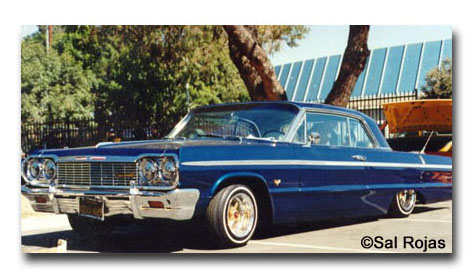Arte y Estilo : The Lowriding Tradition
 Lowriding evolved into a full-blown car culture in the
years following World War II, when members of the Los Angeles Mexican American
community found in lowriding an outlet for self-expression and cultural pride.
In the late 1940s enthusiasts began turning cars into works of art.
Affectionately nicknamed ranflas, carritos, or carruchas, the car's became
highly ornamented symbols of identity, representing both the individual car
owner and his or her culture. Many lowriders began to organize car clubs in the
1960s, the same period in which hot rodding and cruising became popular among
predominanty Anglo youth.
Lowriders distinguished themselves from hot
rodders by driving "low and slow" - "bajito y suavecito" - sometimes dragging
the body of their cars so low to the pavement that they created dramatic sprays
of sparks. Lowrider customizing began to incorporate creative painted murals
with historic and religious themes, featuring figures such as la Virgen de
Guadalupe, Aztec warriors, as well as images from pop culture. Lavish additional
features -- sound systems , upholstery, glass etching and hydraulics - amplified
the lowriding experience. Like other automotive hobbyists, lowriders spend
considerable time, money and skill on perfecting their rides.
In the
1960s, cruising on Whittier Boulevard and at other urban locales was an
important form of public display for lowriders, but a ban on cruising in the
1970s turned the car show into the key locale for lowriding culture. Whether the
cars are found on the street or in the showroom, the lowriding tradition remains
a vibrant phenomenon expressing arte y estilo.
in the gallery
At the video kiosks, watch "Hopping,""History of Hydraulics," and
"Cruising."
The murals on the vehicles often tell a story. Can you identify historical
or religious symbols in any of the murals? What types of stories are told? How
does the name of the car or bike contribute to the story?
Compare the lowrider cars of the 1950s in this exhibit with the hot rodders
of the same era by visiting the Streetscape on the first floor, in front of
Jamm's Drive-In Restaurant.
in the resource area:
Watch Low and Slow on the gallery's large screen monitor.
Arte y Estilo: The Lowriding Tradition, our exhibition catalogue, can be
viewed in the resource area.
a closer look:Each generation brings a unique aesthetic vision to
its car customizing. Compare the murals on a pioneering car like "Gypsy Rose" to
a more contemporary example, such as "Midnight Illusions." What is the
difference?
Lowriders are diverse group of people. While this exhibtion
features the cars of Mexican Americans, African Americans as well as some Asians
and Anglos are also active in lowriding. Lowriding is popular in the Southwest
and it Texas, and more recently, on the East Coast. Lowriders can even be found
in countries like Japan.
Although the car clubs began as male-oriented
fellowships, women have become increasingly visible. For example, filmmaker
Monica Delgado talks about her ties to lowriders in the gallery video, Low and
Slow.
The stereotype of street violence has often been attached to
lowrider culture, but many lowriders consider the car clubs to be an important
alternative to gangs. Car club membership is an incentive to be a responsible
and creative community advocate. Family is important is most lowriding clubs,
and members of the younger generation grow up customizing bikes and go-carts as
a crucial first step in learning the art and skills of self-expression.
TERMS:Aztlan:
Legendary northern homeland of the Aztec
people, refers to the Southwestern United States, which belonged to Mexico until
the 1830s.
bomb:
A lowered, usually mildly customized '30s or '40s
lowrider.
Candy:
A paint finish achieved by spraying a base coat
of silver. gold, or another color and then applying several coats of contrasting
translucent top-coat colors.
Chop:
To lower a car roof by removing
sections of metal from the windshield posts, door pillars, and rear roof
quarters.
Lowriding block:
A cube-shaped metal placed between the
axle and springs to drop the ride height of the chassis.
|
|




